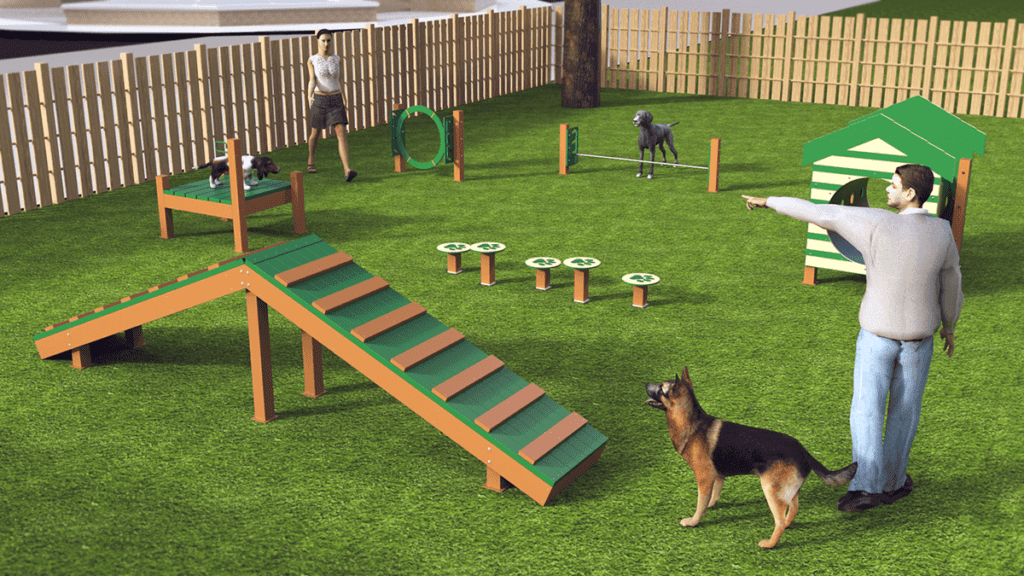Dog agility is a great way to bond with your pet. It also allows your dog to meet other dogs and people in a safe, controlled environment.
If you are considering participating in agility, look for a trainer with a professional attitude and suitable training methods. Consider looking at their training records and reading testimonials from previous clients.
Contact Obstacles
A dog agility course relies on contact obstacles, including equipment like A-frames, dog walks, and see-saws. These pieces of equipment require the dog to scale them physically, and they must be used safely and correctly. These contact obstacles have ‘contact zones’ painted on them, which enforce safe training techniques since handlers will be faulted for a dog’s feet failing to touch the designated area when ascending/descending these pieces of equipment.
In competitions, the order of obstacles varies from trial to trial, and dogs are grouped according to size and experience level. A judge designs each course, and handlers have five minutes to walk through it without their dogs, memorizing the order of the obstacles and planning their handling strategy.
When choosing an agility trainer, look for someone who follows recommended safety protocols and uses positive reinforcement. Also, please pay attention to the trainer’s teaching style and ask for testimonials about other dog owners’ experiences with the trainer and their dogs. Choose a trainer to provide you and your pet with the most fun, rewarding agility experience possible.
Weave Poles
Dog agility requires the use of many different kinds of obstacles. One of the most difficult to train is the weave poles, which consist of twelve upright poles placed side-by-side and slightly angled so that the dog must run through them in a pattern of in and out. This is an unnatural motion for dogs, and it can be hard for them to understand if you are helping them through the process by running beside them or simply luring them in and out with your hands and treats.
To perform the weave correctly at speed, your dog must be able to enter and exit the poles independently without your handling assistance. This is important because dogs that enter or exit the poles incorrectly at competition will be faulted (or even disqualified).
When teaching your dog to weave using a channel method, start by having them jump to each location between the poles and then walk to each location. Then, start calling them into the weave and gradually accelerate away from the poles so that you are at least four poles ahead of your dog when they are in the poles.
Dogs in the wild are natural hunters and hounds that must quickly and constantly navigate barriers to pursue their prey. Dog agility allows them to fulfill this instinctual desire and strengthens their owner-dog bond as they work together as a team.
Jumps
When dogs run in the wild, they frequently jump over fallen logs, scale steep hills, and squeeze through narrow paths while chasing prey. Dog agility courses mimic these natural barriers and fulfill your dog’s instinct to chase and hunt.
When choosing a trainer, look for an instructor who emphasizes safety. Watch how the instructor interacts with the dogs and their handlers in class. Pay attention to their teaching style and ask questions. A good trainer should also be punctual and organized. A trainer with a strong reputation and testimonials from other dog owners should be your first choice.
To complete an agility course, your dog needs to be able to follow commands and understand what is expected of them. This requires patience and self-control. In agility classes, your dog will learn to wait patiently at the start line until it’s released to run through the obstacle course. They will also develop an understanding of the sequence of obstacles and be able to anticipate your cues.
The physical demands of agility require your dog to have sound joints and a healthy heart. A veterinarian can perform an overall physical exam to determine if your dog is fit for this fast-paced sport. If your dog has a history of hip or elbow dysplasia or other joint problems, your veterinarian may advise against agility training.
Tunnels
Tunnels are one of the most popular agility obstacles. Almost all dogs love them, but tunnels are also tricky for handlers because they can quickly get “sucked into” them. Many dog agility courses include a tunnel or two, and even more than that in competitions. For this reason, dog agility handlers must work on various control exercises with their dogs, especially regarding tunnels.
The most common tunnel training starts with a straight tunnel large enough for the dog to crawl comfortably. The dog is called to the tunnel and coaxed through by the handler. Once the dog is comfortable with this, a handler can try to keep the connection with their dog while the dog is in the tunnel and make sure the dog turns after exiting the tunnel (if needed). Some agility dogs even need to crouch to run through tunnels because the smaller diameter forces them to do so.
The tunnel is used to practice sequencing and other control exercises in more advanced dog agility training. This requires a lot of self-control on the handler’s part because the handler can’t release their dog to hit the obstacle before the tunnel. This is why it’s essential to train the dog to wait patiently at the start line and learn to do “cross behinds” or other exercises to help them improve their ability to choose the suitable obstacles in a sequence.



